Atelier Manassé was a legendary Austrian photo studio that captured the golden age of cinema and cabaret in Vienna of the 1920s and 1930s. The studio was founded by Olga Spolarics and her husband Adorján von Wlássics.
Image may be NSFW.
Clik here to view.
Lily Damita. Austrian postcard by Iris Verlag, no. 375/1. Photo: Manassé, Wien / Sascha. Publicity still for Das Spielzeug von Paris/Red Heels (Michael Kertesz a.k.a. Michael Curtis, 1925).
Image may be NSFW.
Clik here to view.
Lily Damita. Austrian postcard by Iris Verlag, no. 496. Photo: Manassé, Wien / Sascha. Publicity still for Das Spielzeug von Paris/Red Heels (Michael Kertesz a.k.a. Michael Curtis, 1925).
Image may be NSFW.
Clik here to view.
Olga Tschechova. Austrian postcard by Iris Verlag, no. 756. Photo: Manassé, Wien.
Image may be NSFW.
Clik here to view.
Anita Dorris. Austrian postcard by Iris-Verlag, no. 5488. Photo: Atelier Manassé.
Image may be NSFW.
Clik here to view.
Lien Deyers. Austrian postcard by Iris Verlag, no. 5693. Photo: Manassé, Wien. Collection: Geoffrey Donaldson Instituut.
Atelier Manassé, active from circa 1924 in Vienna and later also in Berlin, was founded by Adorján von Wlássics (1893-1946) and Olga Spolarics (1896-1969), both born in Hungary. Married in 1920, the Wlassics became part of Vienna’s high society, yet very little is known about their lives, education and training.
In the early 1920s, when the studio started, the film industry skyrocketed. From 1919 to 1922, the Austrian film studios like Sascha produced more than 140 films that found a global market. Popular variety shows flourished as well, bringing international stars such as Josephine Baker and the Tiller Girls, a popular British dance troupe, to Vienna.
Manassé's clients ran the gamut from magazine editors and advertising agencies to private buyers. Magazines aimed to satisfy a public obsessed with glimpses into the world of glamour. The Wlassics published their first film photos in publications like Wiener Magazin. The circa 30 magazines in Vienna needed images to accompany the increasing number of articles on film and theatre, in addition to gossip columns, sports news, fashion pieces and melodramatic stories of murder and mayhem.
Atelier Manassé started at the right time and the Wlassicas created masterpieces. They employed all the techniques of makeup, retouching, and over-painting to keep their subjects and buyers happy while upholding an uncompromised artistic vision. For us today, the studio’s rich visual legacy in part chronicles the golden era of cinema and theatre in Europe.
Kristine Somerville in her article Darkroom Alchemy: The Photographic Art of Studio Manassé at ResearchGate: "Styling, staging and photographic work was handled by Olga. She created the glamorous Manassé vision in their small but dazzling apartment, which also served as their studio in Vienna’s city center. The rooms and reception area were filled with lavish furnishings—bearskin rugs, Baroque furniture, tapestries, gilded mirrors, paintings and Greek pillars used as flower stands—which often appeared as backgrounds or props."
Somerville: "Adorján handled the artistic corrections and montages. He devoted a remarkable amount of time and ingenuity to perfecting techniques— primarily retouching, painting and overlaying images—to enhance Olga’s photographs."
Till 1938 many European but also Hollywood film stars and starlets were photographed in the Manassé studio. Rudolph Valentino, Anna May Wong, French Lily Damita, and the legendary La Jana were among the stars who were photographed by the Wlassics.
Image may be NSFW.
Clik here to view.
Mary Kid. German postcard by Ross Verlag, no. 3348/3, 1928-1929. Photo: Manassé, Wien.
Image may be NSFW.
Clik here to view.
Maria Paudler. German postcard by Ross Verlag, no. 3583/1, 1928-1929. Photo: Manassé, Wien. Caption: Doppelbildnis (double portrait).
Image may be NSFW.
Clik here to view.
Maly Delschaft. German postcard by Ross Verlag, no. 3653/1, 1928-1929. Photo: Atelier Manassé, Wien.
Image may be NSFW.
Clik here to view.![Vera Voronina]()
Vera Voronina. German postcard by Ross Verlag, no. 3654/2, 1928-1929. Photo: Atelier Manassé, Wien.
Atelier Manassé also gained a high degree of popularity in the 1920s through erotic photographs, mainly of women.
Olga Spolarics (1896-1969) seems to have been the one interested in the nude photography. Atelier Manassé exhibited at the 1st International Salon of Nude Photography in Paris in 1933.
The artists liked to combine erotic with surreal motifs in their photographs. They used retouching techniques to create surreal and noir images that seethe with an erotic symbolism barely concealed beneath a mask of glorious styling, elegant poses, and extravagant costumes.
In 1934, an entire edition of Muskete, a humorous magazine known for its caricature and pictorial jokes, was confiscated by Austrian censors. The Wlassics had failed to remove in the darkroom all traces of pubic hair on their nude cover photo.
The cover picture was one of their 'photographic jokes'. This genre was popularised by postcards that employed trick photography to depict such images as pretty girls growing on trees, the cherubic face of a loved one appearing in a wreath of pipe smoke or a lithe young woman hanging seductively from a businessman’s necktie.
The Wlassics went back to their studio and amended the photo, and the next month the magazine was republished without issue.
Image may be NSFW.
Clik here to view.![Ossi Oswalda]()
Ossi Oswalda. German postcard by Ross Verlag, no. 4244/1, 1929-1930. Photo: Atelier Manassé, Wien.
Image may be NSFW.
Clik here to view.![Anita Dorris]()
Anita Dorris. German postcard by Ross Verlag, no. 5030/1, 1930-1931. Photo: Manassé, Wien.
Image may be NSFW.
Clik here to view.![Ruth Weyher]()
Ruth Weyher. German postcard by Ross Verlag, no. 5037/1, 1930-1931. Photo: Atelier Manassé, Wien.
Image may be NSFW.
Clik here to view.![Liane Haid]()
Liane Haid. German postcard by Ross Verlag, no. 5034/1, 1930-1931. Photo: Manassé, Wien (Vienna).
When Adorján von Wlássics and Olga Spolarics opened a new, smaller studio in Berlin, their business in Vienna was managed more and more by an associate.
They operated under various names, including Wlasics (the first name of the studio), WOG (in their Berlin studio) and Manassé-Ricoll (after the studio in Vienna was operated by an associate).
After the death of Adorján von Wlassics in 1947, the fame of the studio faded. Olga remarried and died in 1969.
In 1998 their photos were rediscovered through the publication Divas and lovers: the erotic art of Studio Manassé, by photographic historian Monika Faber, curator in the department of drawing and photography in the Museum of Modern Art in Vienna.
Billyjane & Drake Caperton regularly post pictures of Atelier Manassé on Facebook and Tumblr.
Image may be NSFW.
Clik here to view.![Gretl Berndt]()
Gretl Berndt. German postcard by Ross Verlag, no. 5326/1, 1930-1931. Photo: Atelier Manassé, Wien.
Image may be NSFW.
Clik here to view.![Anna May Wong]()
Anna May Wong. German postcard by Ross Verlag, no. 5477/1, 1930-1931. Photo: Atelier Manassé, Wien (Vienna).
Image may be NSFW.
Clik here to view.![La Jana]()
La Jana. German postcard by Ross Verlag, no. 5485/1, 1930-1931. Photo: Atelier Manassé, Wien. Collection: Didier Hanson.
Image may be NSFW.
Clik here to view.![Lien Deyers]()
Lien Deyers. German postcard by Ross Verlag, no. 8842/1, 1933-1934. Photo: Atelier Manassé, Wien.
Image may be NSFW.
Clik here to view.![Traudl Stark]()
Traudl Stark. German postcard by Ross Verlag, no. A 1276/1, 1937-1938. Photo: Manassé-Ricoll, Wien / Mondial-Film.
Sources: Monika Faber (Divas and Lovers), Kristine Somerville (Darkroom Alchemy - ResearchGate), Billyjane & Drake Caperton (Facebook and Tumblr - Studio Manasse), Historical Ziegfield Group and Wikipedia (German).
Image may be NSFW.
Clik here to view.
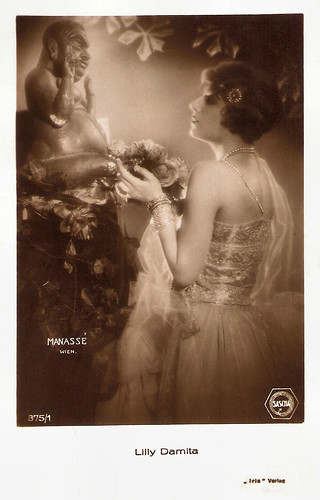
Lily Damita. Austrian postcard by Iris Verlag, no. 375/1. Photo: Manassé, Wien / Sascha. Publicity still for Das Spielzeug von Paris/Red Heels (Michael Kertesz a.k.a. Michael Curtis, 1925).
Image may be NSFW.
Clik here to view.
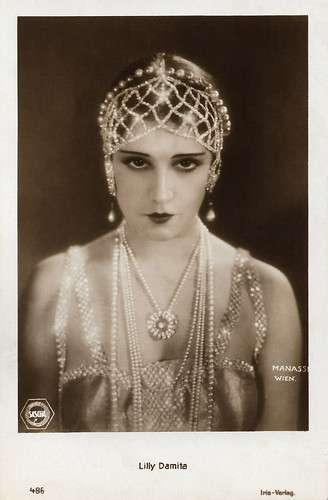
Lily Damita. Austrian postcard by Iris Verlag, no. 496. Photo: Manassé, Wien / Sascha. Publicity still for Das Spielzeug von Paris/Red Heels (Michael Kertesz a.k.a. Michael Curtis, 1925).
Image may be NSFW.
Clik here to view.
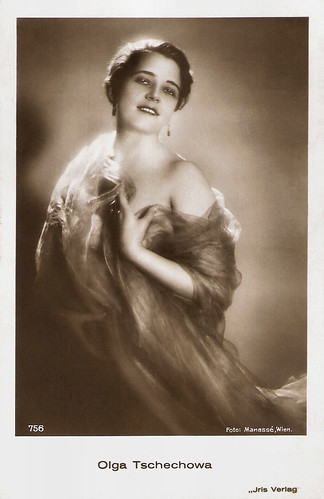
Olga Tschechova. Austrian postcard by Iris Verlag, no. 756. Photo: Manassé, Wien.
Image may be NSFW.
Clik here to view.
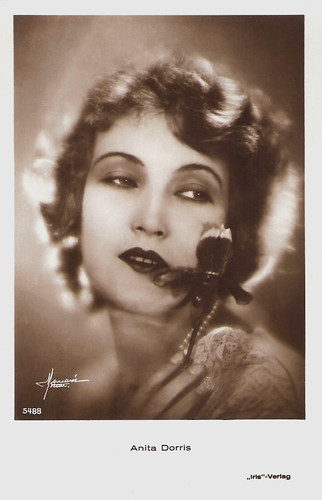
Anita Dorris. Austrian postcard by Iris-Verlag, no. 5488. Photo: Atelier Manassé.
Image may be NSFW.
Clik here to view.

Lien Deyers. Austrian postcard by Iris Verlag, no. 5693. Photo: Manassé, Wien. Collection: Geoffrey Donaldson Instituut.
Glimpses Into the World of Glamour
Atelier Manassé, active from circa 1924 in Vienna and later also in Berlin, was founded by Adorján von Wlássics (1893-1946) and Olga Spolarics (1896-1969), both born in Hungary. Married in 1920, the Wlassics became part of Vienna’s high society, yet very little is known about their lives, education and training.
In the early 1920s, when the studio started, the film industry skyrocketed. From 1919 to 1922, the Austrian film studios like Sascha produced more than 140 films that found a global market. Popular variety shows flourished as well, bringing international stars such as Josephine Baker and the Tiller Girls, a popular British dance troupe, to Vienna.
Manassé's clients ran the gamut from magazine editors and advertising agencies to private buyers. Magazines aimed to satisfy a public obsessed with glimpses into the world of glamour. The Wlassics published their first film photos in publications like Wiener Magazin. The circa 30 magazines in Vienna needed images to accompany the increasing number of articles on film and theatre, in addition to gossip columns, sports news, fashion pieces and melodramatic stories of murder and mayhem.
Atelier Manassé started at the right time and the Wlassicas created masterpieces. They employed all the techniques of makeup, retouching, and over-painting to keep their subjects and buyers happy while upholding an uncompromised artistic vision. For us today, the studio’s rich visual legacy in part chronicles the golden era of cinema and theatre in Europe.
Kristine Somerville in her article Darkroom Alchemy: The Photographic Art of Studio Manassé at ResearchGate: "Styling, staging and photographic work was handled by Olga. She created the glamorous Manassé vision in their small but dazzling apartment, which also served as their studio in Vienna’s city center. The rooms and reception area were filled with lavish furnishings—bearskin rugs, Baroque furniture, tapestries, gilded mirrors, paintings and Greek pillars used as flower stands—which often appeared as backgrounds or props."
Somerville: "Adorján handled the artistic corrections and montages. He devoted a remarkable amount of time and ingenuity to perfecting techniques— primarily retouching, painting and overlaying images—to enhance Olga’s photographs."
Till 1938 many European but also Hollywood film stars and starlets were photographed in the Manassé studio. Rudolph Valentino, Anna May Wong, French Lily Damita, and the legendary La Jana were among the stars who were photographed by the Wlassics.
Image may be NSFW.
Clik here to view.
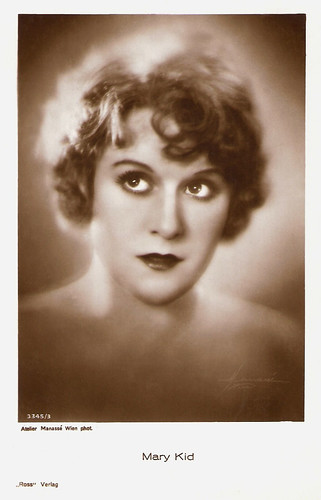
Mary Kid. German postcard by Ross Verlag, no. 3348/3, 1928-1929. Photo: Manassé, Wien.
Image may be NSFW.
Clik here to view.
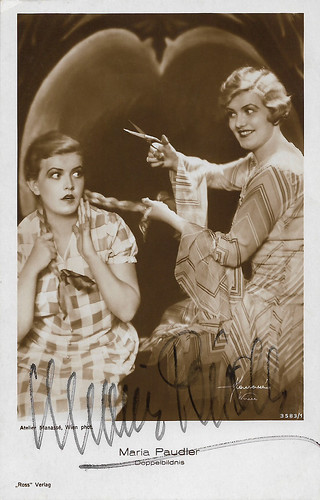
Maria Paudler. German postcard by Ross Verlag, no. 3583/1, 1928-1929. Photo: Manassé, Wien. Caption: Doppelbildnis (double portrait).
Image may be NSFW.
Clik here to view.
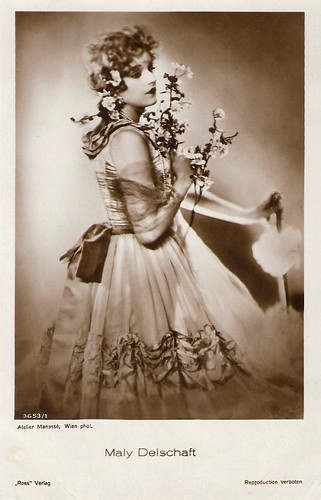
Maly Delschaft. German postcard by Ross Verlag, no. 3653/1, 1928-1929. Photo: Atelier Manassé, Wien.
Image may be NSFW.
Clik here to view.
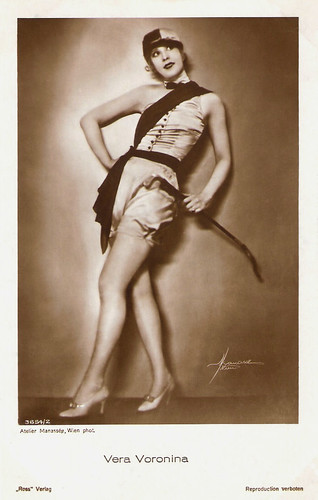
Vera Voronina. German postcard by Ross Verlag, no. 3654/2, 1928-1929. Photo: Atelier Manassé, Wien.
Nude Photography
Atelier Manassé also gained a high degree of popularity in the 1920s through erotic photographs, mainly of women.
Olga Spolarics (1896-1969) seems to have been the one interested in the nude photography. Atelier Manassé exhibited at the 1st International Salon of Nude Photography in Paris in 1933.
The artists liked to combine erotic with surreal motifs in their photographs. They used retouching techniques to create surreal and noir images that seethe with an erotic symbolism barely concealed beneath a mask of glorious styling, elegant poses, and extravagant costumes.
In 1934, an entire edition of Muskete, a humorous magazine known for its caricature and pictorial jokes, was confiscated by Austrian censors. The Wlassics had failed to remove in the darkroom all traces of pubic hair on their nude cover photo.
The cover picture was one of their 'photographic jokes'. This genre was popularised by postcards that employed trick photography to depict such images as pretty girls growing on trees, the cherubic face of a loved one appearing in a wreath of pipe smoke or a lithe young woman hanging seductively from a businessman’s necktie.
The Wlassics went back to their studio and amended the photo, and the next month the magazine was republished without issue.
Image may be NSFW.
Clik here to view.

Ossi Oswalda. German postcard by Ross Verlag, no. 4244/1, 1929-1930. Photo: Atelier Manassé, Wien.
Image may be NSFW.
Clik here to view.
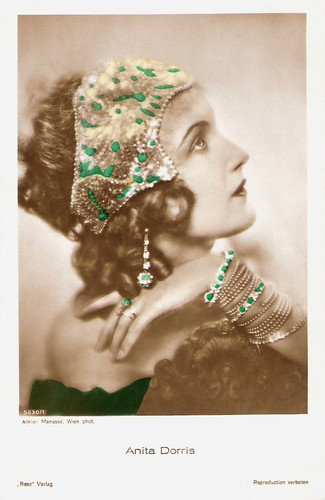
Anita Dorris. German postcard by Ross Verlag, no. 5030/1, 1930-1931. Photo: Manassé, Wien.
Image may be NSFW.
Clik here to view.
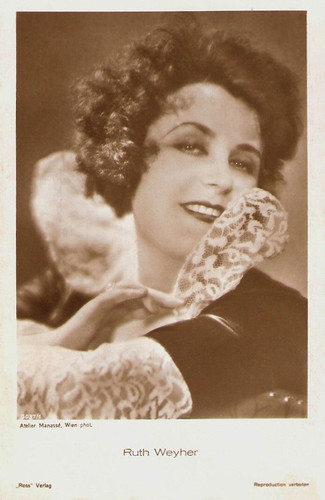
Ruth Weyher. German postcard by Ross Verlag, no. 5037/1, 1930-1931. Photo: Atelier Manassé, Wien.
Image may be NSFW.
Clik here to view.
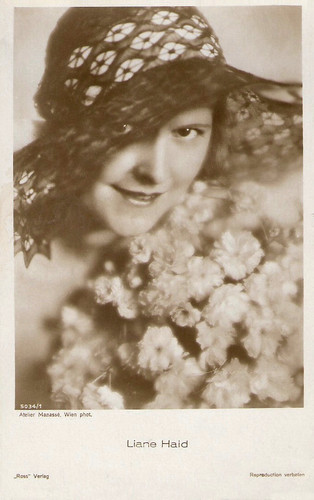
Liane Haid. German postcard by Ross Verlag, no. 5034/1, 1930-1931. Photo: Manassé, Wien (Vienna).
Divas and lovers
When Adorján von Wlássics and Olga Spolarics opened a new, smaller studio in Berlin, their business in Vienna was managed more and more by an associate.
They operated under various names, including Wlasics (the first name of the studio), WOG (in their Berlin studio) and Manassé-Ricoll (after the studio in Vienna was operated by an associate).
After the death of Adorján von Wlassics in 1947, the fame of the studio faded. Olga remarried and died in 1969.
In 1998 their photos were rediscovered through the publication Divas and lovers: the erotic art of Studio Manassé, by photographic historian Monika Faber, curator in the department of drawing and photography in the Museum of Modern Art in Vienna.
Billyjane & Drake Caperton regularly post pictures of Atelier Manassé on Facebook and Tumblr.
Image may be NSFW.
Clik here to view.
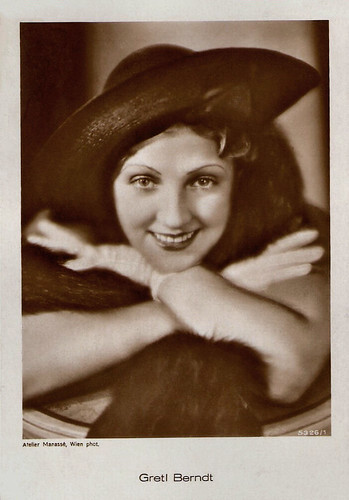
Gretl Berndt. German postcard by Ross Verlag, no. 5326/1, 1930-1931. Photo: Atelier Manassé, Wien.
Image may be NSFW.
Clik here to view.
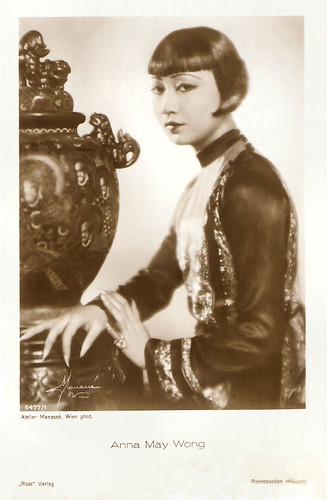
Anna May Wong. German postcard by Ross Verlag, no. 5477/1, 1930-1931. Photo: Atelier Manassé, Wien (Vienna).
Image may be NSFW.
Clik here to view.
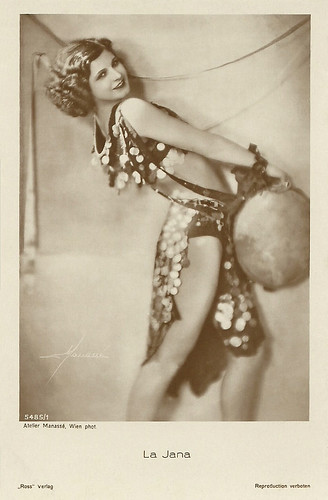
La Jana. German postcard by Ross Verlag, no. 5485/1, 1930-1931. Photo: Atelier Manassé, Wien. Collection: Didier Hanson.
Image may be NSFW.
Clik here to view.

Lien Deyers. German postcard by Ross Verlag, no. 8842/1, 1933-1934. Photo: Atelier Manassé, Wien.
Image may be NSFW.
Clik here to view.
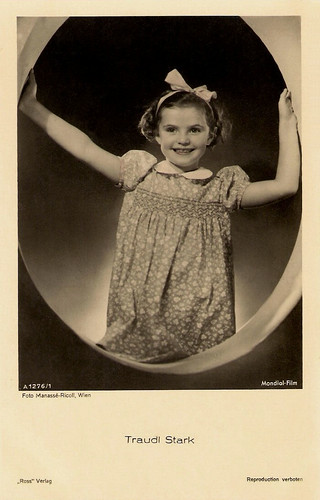
Traudl Stark. German postcard by Ross Verlag, no. A 1276/1, 1937-1938. Photo: Manassé-Ricoll, Wien / Mondial-Film.
Sources: Monika Faber (Divas and Lovers), Kristine Somerville (Darkroom Alchemy - ResearchGate), Billyjane & Drake Caperton (Facebook and Tumblr - Studio Manasse), Historical Ziegfield Group and Wikipedia (German).